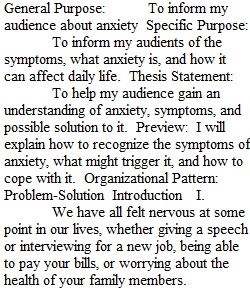


Q A Content Outline identifies what you intend to present in your speech, in the order it needs to be presented in. Directions: 1. Make sure to double-space your outline 2. At the top of your outline, indicate your speech’s General Purpose, Specific Purpose, Thesis Statement, Preview, and Organizational Pattern. This header information is just to quickly let me know what your speech is about. 3. From beginning to end, each point in your outline should only contain one complete sentence identifying one idea. 4. Your outline should have a clearly indicated Introduction, Body, and Conclusion. 5. Include transitions between your main points in the Body section. 6. Include a Parenthetical Citation at the end of points that are citing research, like this (Author, Title, Date). 7. You do NOT need to include a Works Cited or References page of the sources you consulted - Parenthetical Citations are good enough for our purposes. Here is an Example Mind Map to show how you can focus a topic with the different organizational patterns: Word Download Wordor PDF Download PDF Here is a Blank Mind Map so you can use it to funnel your own ideas into a focused speech topic: Word or PDF Download PDF You may use this Outline Template to help you get started: Word Download Wordor PDF Download PDF Here is an example and summary of How To Use Demonstration Points (1, 2, 3) And Parenthetical Citations in your outline: Word Download Wordor PDF Download PDF You may use these Outline Examples from our textbook (pg. 272-277) to help guide you: PDF Download PDF *The Speaking Notes you use to guide your presentation may have your Thesis Statement written out as a complete sentence, and direct quotes from sources written out fully if they are 3 sentences or less. You may paraphrase direct quotes from sources that are longer than 3 sentences in your own words of 1-3 sentences. Otherwise, every point in your outline should be a few Keywords or a Key Phrase to jog your memory.* Rubric Informative Speech Outline Rubric (1) Informative Speech Outline Rubric (1) Criteria Ratings Pts This criterion is linked to a Learning OutcomeHeader Information General Purpose, Specific Purpose, Thesis Statement, Preview, and Organizational Pattern correctly indicated at the top of the outline. 6 pts Excellent 5 pts Good 4 pts Acceptable 3 pts Poor 2 pts Deficient 0 pts Missing 6 pts This criterion is linked to a Learning OutcomeOne-sentence Format Each point is written as one complete sentence identifying one idea to explain. 6 pts Excellent 5 pts Good 4 pts Acceptable 3 pts Poor 2 pts Deficient 0 pts Missing 6 pts This criterion is linked to a Learning OutcomeSubordination and Coordination Main points identified with Roman Numerals (I, II, III); Subpoints identified with Capital Letters (A, B, C); Demonstration points identified with Numbers (1, 2, 3) 6 pts Excellent 5 pts Good 4 pts Acceptable 3 pts Poor 2 pts Deficient 0 pts Missing 6 pts This criterion is linked to a Learning OutcomeSection Identifiers Clearly identified sections for the Introduction, Body and Conclusion. 6 pts Excellent 5 pts Good 4 pts Acceptable 3 pts Poor 2 pts Deficient 0 pts Missing 6 pts This criterion is linked to a Learning OutcomeParenthetical Citations Author, Title, and Date (as available) are included in parenthesis at the ends of points citing research. 6 pts Excellent 5 pts Good 4 pts Acceptable 3 pts Poor 2 pts Deficient 0 pts Missing 6 pts Total Points: 30 PreviousNext
View Related Questions